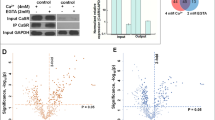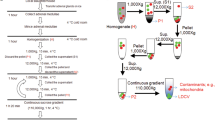Abstract
MANY cellular functions are regulated by activation of cell-surface receptors that mobilize calcium from internal stores sensitive to inositol 1,4,5-trisphosphate (Ins(l,4,5)P3) (ref. 1). The nature of these internal calcium stores and their localization in cells is not clear and has been a subject of debate. It was originally suggested2–5 that the Ins(l,4,5)P3-sensitive store is the endoplasmic reticulum, but a new organelle, the calciosome, identified by its possession of the calcium-binding protein, calsequestrin6, and a Ca2+-ATPase-like protein7 of relative molecular mass 100,000 (100K), has been described as a potential Ins(l,4,5)P3-sensitive calcium store. Direct evidence on whether the calciosome is the Ins(l,4,5)P3-sensitive store is lacking. Using monoclonal anti-bodies raised against the Ca2+-ATPase of skeletal muscle sarcoplasmic reticulum8, we show that bovine adrenal chromaffin cells contain two Ca2+-ATPase-like proteins with distinct subcellular distributions. A 100K Ca2+-ATPase-like protein is diffusely distributed, whereas a 140K Ca2+-ATPase-like protein is restricted to a region in close proximity to the nucleus. In addition, Ins(l,4,5)P3-generating agonists result in a highly localized rise in cytosolic calcium concentration ([Ca2+]i) initiated in a region close to the nucleus, whereas caffeine results in a rise in [Ca2+]i throughout the cytoplasm. Our results indicate that chromaffin cells possess two calcium stores with distinct Ca2+-ATPases and that the organelle with the 100K Ca2+-ATPase is not the Ins(l,4,5)P3-sensitive store.
This is a preview of subscription content, access via your institution
Access options
Subscribe to this journal
Receive 51 print issues and online access
$199.00 per year
only $3.90 per issue
Buy this article
- Purchase on Springer Link
- Instant access to full article PDF
Prices may be subject to local taxes which are calculated during checkout
Similar content being viewed by others
References
Berridge, M. J. A. Rev. Biochem. 56, 159–193 (1987).
Bayerdorffer, E., Streb, H., Eckhardt, L., Haase, W. & Schulz, J. J. Memb. Biol. 81, 69–82 (1984).
Prentki, M. et al. Nature 309, 562–564 (1984).
Streb, H., Bayerdorffer, E., Haase, W., Irvine, R. F. & Schultz, I. J. memb. Biol. 81, 241–253 (1984).
Biden, T. J., Wollheim, C. B. & Schlegel, W. J. biol. Chem. 261, 7223–7229 (1986).
Volpe, P. et al. Proc. natn. Acad. Sci. U.S.A. 85, 1091–1095 (1988).
Hashimoto, S. et al. J. Cell Biol. 107, 2523–2531 (1988).
Colyer, J., Mata, A. M., Lee, A. G. & East, J. M. Biochem. J. 262, 439–447 (1989).
Cheek, T. R., O'Sullivan, A. J., Moreton, R. B., Berridge, M. J. & Burgoyne, R. D. FEBS Lett. 247, 429–434 (1989).
O'Sullivan, A. J., Cheek, T. R., Moreton, R. B., Berridge, M. J. & Burgoyne, R. D. EMBO J. 8, 401–411 (1989).
Cheek, T. R. J. Cell Sci. 93, 211–216 (1989).
Ghosh, T. K., Mullaney, J. M., Tarazi, F. I. & Gill, D. L. Nature 340, 236–239 (1989).
Ross, C. A. et al. Nature 339, 468–470 (1989).
Poisner, A. M. Proc. Soc. exp. Biol. Med. 142, 103–105 (1973).
Damiani, E., Spamer, C., Heilmann, C., Salvatori, S. & Magreth, A. J. biol. Chem. 263, 340–343 (1988).
Gill, D. L., Ueda, T., Chueh, S. H. & Noel, M. W. Nature 320, 461–464 (1986).
Kanaide, H., Shogakiuchi, Y. & Nakamura, M. FEBS Lett 214, 130–134 (1987).
Thayer, S. A., Perney, T. M. & Miller, R. J. J. Neurosci. 8, 4089–4097 (1988).
Busa, W. B., Ferguson, J. E., Joseph, S. K., Williamson, J. R. & Nucitelli, R. J. Cell Biol. 101, 677–682 (1985).
Saida, K. & van Breemen, C. Pflugers Arch. 397, 166–167 (1983).
Woods, N. M., Cuthbertson, K. S. R. & Cobbold, P. H. Nature 319, 600–602 (1986).
Berridge, M. J. J. Physiol., Lond. 403, 589–599 (1988).
Berridge, M. J. & Galione, A. Fedn Proc. 2, 3074–3082 (1988).
Thomas, A. P. J. biol. Chem. (in the press).
Burgoyne, R. D. & Morgan, A. FEBS Lett. 245, 122–126 (1989).
Grynkiewicz, G., Poenie, M. & Tsien, R. Y. J. biol. Chem. 260, 3440–3450 (1985).
Author information
Authors and Affiliations
Rights and permissions
About this article
Cite this article
Burgoyne, R., Cheek, T., Morgan, A. et al. Distribution of two distinct Ca2+ -ATPase-like proteins and their relationships to the agonist-sensitive calcium store in adrenal chromaff in cells. Nature 342, 72–74 (1989). https://doi.org/10.1038/342072a0
Received:
Accepted:
Issue Date:
DOI: https://doi.org/10.1038/342072a0
This article is cited by
-
Molecular and functional characterization of a mutant allele of the mitogen-activated protein-kinase geneSLT2(MPK1) rescued from yeast autolytic mutants
Current Genetics (1996)
-
Caffeine-resistance in fission yeast is caused by mutations in a single essential gene,crm1 +
Molecular and General Genetics MGG (1996)
-
Nuclear calcium signaling is initiated by cytosolic calcium surges in vascular smooth muscle cells
Kidney International (1994)
-
Effects of caffeine on intracellular calcium, calcium current and calcium-dependent potassium current in anterior pituitary GH3 cells
Pfl�gers Archiv European Journal of Physiology (1994)
-
Annexin II (calpactin I) in the mouse mammary gland: immunolocalisation by light- and electron microscopy
Cell and Tissue Research (1991)
Comments
By submitting a comment you agree to abide by our Terms and Community Guidelines. If you find something abusive or that does not comply with our terms or guidelines please flag it as inappropriate.



